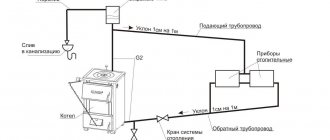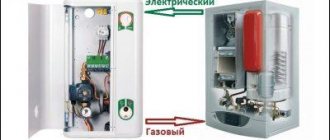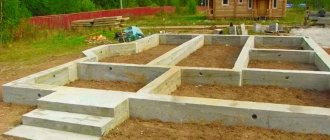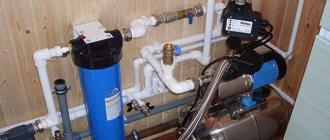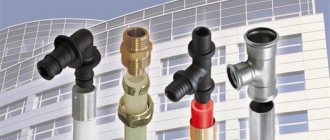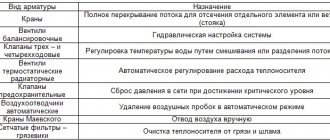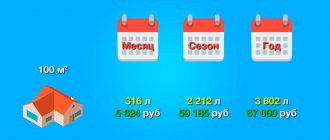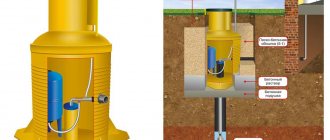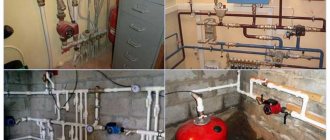Types and their brief description
Let's consider the classification of gas boilers according to various criteria:
- Based on the installation method, a distinction is made between floor-standing and wall-mounted boilers . The floor-standing unit is very powerful and is used to heat a building up to 200 sq.m., as it works together with a boiler. Wall-mounted gas boilers are more modest in size and are equipped with various devices necessary for good operation: a thermostat with a lock, a flame sensor, draft control, and automatic shutdown in case of power outages.
- By the number of contours . Single-circuit boilers are designed for one thing: either heating a room or supplying hot water. Dual-circuit models are used for both functions simultaneously.
- By type of combustion product emissions . Models with conventional draft produce emissions due to the constant flow of air from outside the building. Forced draft boilers are installed with a closed combustion chamber and a coaxial chimney.
- In terms of energy efficiency . Traditional (convection) models use a low calorific value, but require the creation of the necessary conditions to avoid condensation. There are also condensing models that use the highest calorific value and heat the air due to the formation of water vapor from combustion products on the walls of the economiser.
- By type of ignition . The device with electric ignition works automatically and is very economical. The piezo ignition must be turned on manually by pressing a special button.
We select a boiler according to different parameters
Now it’s time to talk about how to select a heating boiler according to its parameters. These parameters include the area of heated premises and the power of heating equipment.
Let's look at how to make the right selection of a heating boiler based on area. There are several points to consider:
- If your house is insulated according to the standards, its ceilings are 3 m, then the power will be determined at the rate of 1 kW per 10 sq.m.
- If the house is not insulated in the best way, or verandas and uninsulated attics are heated, then the power will be greater.
- If the boiler will be used not only to heat the house, but also to supply hot water, then the power will be increased by 20-50%.
Of course, if you do not have certain special knowledge, then you will only make an approximate choice of heating boiler power. After all, if you apply a more complex formula, then some more indicators are included.
Boiler power depending on the area of the house
Let's consider the formula for calculating the power of a heating boiler. Boiler power is the most important operating parameter. This does not depend on what type of fuel will be used in the future. If the power is not enough, you will freeze; if, on the contrary, you buy a device that is too powerful, then you will overpay.
To select the power of a heating boiler, consider the formula. So, this includes the following parameters:
- Room area S.
- Specific boiler power per 10 sq.m of premises Wud. – taking into account climatic conditions: Moscow and the region – 1.5 kW, North – 1.5 – 2 kW, South – 0.7 – 0.9 kW.
The formula will look like this: Boiler power = SWud./10.
When choosing a boiler, first of all it is necessary to calculate the energy demand of the heating object. The parameters of the heating system are calculated according to the heat loss of the room, which depends on the size of the room, the thermal conductivity of external walls, internal partitions and ceilings, the difference between external and internal air temperatures, therefore the final determination of the boiler power should be trusted only to professional heating engineers. But it is possible to pre-determine the power of the boiler, and accordingly, the cost of the equipment and its other parameters independently. Approximately, you can use the following ratio - 1.2 kW of boiler power is required to heat approximately 10 m2 of a well-insulated room with a ceiling height of up to 3 m.
The defining parameters that should be relied upon when calculating power are:
- area of the heated room (S);
- specific boiler power per 10m? premises, which is set taking into account amendments to the climatic conditions of the region (W spec.).
There are generally accepted specific power values for climatic zones:
- for the Moscow region - W beat. = 1.2 - 1.5 kW;
- for the Northern regions - W beat. = 1.5 - 2.0 kW;
- for the Southern regions - W beat. = 0.7 - 0.9 kW.
Calculation of boiler power (W cat) is carried out according to the formula:
W cat. = SW beat / 10
Often, for the convenience of calculations, the average value of W beat is used. equal to one. Based on this, it is customary to choose the boiler power at the rate of 10 kW per 100 m 2 of heated space.
Example:
1. Area of the heated room S = 100 m²;
2. Specific power (Wsp.) for the Moscow region = 1.2 kW;
W cat. = 100 1.2 / 10 = 12 kW;
The table shows the approximate power of boilers depending on the area of the house served (for the Moscow region).
How to choose and what to pay attention to?
Power - how to calculate correctly
The power of a gas boiler is its main parameter.
To find out the power of the boiler that is needed to heat a certain area of the room, you must use the formula: Boiler power (W) = room area (sq.m.) * 10 (kW/sq.m.) + pool heat exchanger power (W, if any )+ ventilation heater power (W, if any).
To calculate the required boiler power, depending on the area and heat losses of the house, it is best to use the help of a specialist who:
- Determines the dimensions of the building and the area of all walls.
- Measure the area of all doors and windows.
- Calculate heat loss.
Number of circuits
According to the number of circuits, gas boilers are divided into:
- Single-circuit . It has only one heat exchanger, which is responsible for supplying heat to the room. Ideal for a large country house, since such buildings usually have several water points.
- Dual-circuit . Such a boiler includes two heat exchangers, which are connected to different lines. One of them is responsible for heat in the house, the second for hot water. The last heat exchanger is heated using coolant from the unit, which is responsible for heating the room. The flow of coolant through the heating circuit stops when the hot water supply is running. This means that a double-circuit boiler cannot provide simultaneous operation of hot water supply and heating. A double-circuit boiler is perfect for a small private house: you don’t have to install separate heating equipment and a separate water heater. This model will perfectly save space in the room.
Installation method
According to the installation method, gas boilers are of two types:
- Wall mounted . Compact, lightweight models that do not require a separate room. They can be installed both in the kitchen and in the bathroom. Such boilers do not have much power and will not be able to heat a large house. The heat exchanger of wall-mounted boilers is made of steel. It is worth noting the inexpensive price of such models.
- Floor-standing . Such boilers have impressive dimensions and heavy weight (up to 100 kg). Such units are usually located in boiler rooms. Floor-standing boilers most often have an open combustion chamber, which requires high-quality forced ventilation in the house. Due to their large size, floor-standing models are very powerful and can heat a large private house. In addition, such units last longer, as they are made of the highest quality materials (for example, a heat exchanger made of cast iron). Floor-standing boilers are much more expensive than wall-mounted ones, and you will also have to purchase circulation pumps and an expansion tank separately.
Type of ignition and burner
Common ignition options in gas boilers are:
- Piezo ignition . The action of this ignition is semi-automatic and is similar to the operation of the piezoelectric element in conventional lighters. In the boiler device, on the body of the gas boiler, there is a special valve. Pressing this button activates the unit - a spark appears and the gas combustion process starts. Piezo ignition should be chosen for its convenient design and operation without interaction with electricity.
- Electric ignition . In this case, the gas boiler begins to operate in automatic mode. This results in good energy savings. However, electric ignition requires a connection to electricity, and if there are problems with it, the gas boiler will not warm up. At the same time, a boiler with electric ignition has a protection system that blocks access to energy.
Gas burners come in a . The former function due to the natural flow of oxygen (requires good ventilation and chimneys to remove combustion products).
The second type of burner is the most modern, equipped with compact chimneys extending outside the building. A turbocharged burner is practically safe - the gas burns in an isolated chamber.
Heat exchanger material and design
A single-circuit boiler has a simple structure: its heat exchanger consists of steel plates, which increase the heat capacity of the device, and copper pipes, through which the thermal conductivity of the building’s heating system circulates.
Such a heat exchanger is primary, its task is to transfer the energy of fuel combustion to the coolant burner.
A double-circuit boiler has a secondary (plate) heat exchanger, which consists of plates and pipes . It prepares liquid for hot water supply to the room. Such a heat exchanger consists of steel, copper or cast iron.
Combustion chamber type
The combustion chambers in a gas boiler are divided into:
- Open . Such boilers take combustion air from the room in which they are located. To use this combustion chamber, good ventilation in the building is necessary so that the exhaust gases move freely into the chimney.
- Closed . Air enters the combustion chamber and is forced out into the chimney using a fan. The unit can take air both from the house and from the street, which is very convenient. Air is taken in through one pipe and exhausted through the other.
Aspirated or turbocharged
There are two types of burners for gas boilers; let’s determine their differences:
- Atmospheric . The product has a standard method for removing combustion products. This burner must be installed together with a smoke exhaust system. Such devices are less powerful than turbocharged ones, but are cheaper.
- Turbocharged . The second name is an inflatable burner. Uses an electric turbine that provides forced ventilation of the combustion chamber. The cost of inflatable burners is quite high.
Additional functions
A high-quality modern gas boiler must include a valve that cuts off the gas supply, as well as a security system with all kinds of sensors.
In addition, gas equipment manufacturers include useful functions in their gas boilers:
- built-in boiler - for filling a large bath or pool with hot water;
- water heated floors - use additional equipment called a mixing unit;
- burner modulation function - for economy, ensures mixing of air and fuel in the correct proportion;
- cascade function - redundancy if any elements fail;
- intelligent regulation - the system selects a certain temperature in each room and changes it depending on the time of day, etc.
What are wall-mounted double-circuit gas boilers?
Modern wall-hung double-circuit boilers have an excellent design, a minimum of communications around them and operate almost silently, so they can be installed in any room that meets the requirements.
Gas mounted double-circuit models with the same dimensions and heating technical characteristics combine the functionality of two devices at once - the boiler itself and a flow-through (less often storage) water heater. The coolant from the heating circuit in dual-circuit models does not mix with sanitary water from the hot water supply (DHW) circuit.
It is advisable to install wall-mounted double-circuit models in small and medium-sized residential buildings with an area of up to 350-400 m2, in which the distance from the boiler to the points of consumption is not too large (7-10 m). Otherwise, preparing and heating running water will take too much time, 20 seconds or more, which negatively affects not only comfort, but also water and fuel consumption.
Another important point is the number of people living in the house, or rather the number of points of simultaneous consumption of hot water. Most dual-circuit models operate on the principle of DHW priority, i.e. when the consumption point opens, the heating circuit is preheated. Less often, usually in more expensive models, where the distribution of performance is implemented using a three-way valve, the heating of the heating circuit does not stop completely, but the performance is still reduced.
In practice, this means that if you use several hot water consumption points at the same time, the performance of the DHW circuit may not be enough, not to mention the heating circuit. Therefore, the total number of rooms with hot water consumption points (bathroom, guest bathroom, kitchen, etc.) should not exceed three.
Design and principle of operation
A visual principle of operation of double-circuit boilers with priority for hot water supply (DHW).
Double-circuit wall-mounted boilers differ from single-circuit boilers only in the presence of an additional heat exchanger and devices for distributing productivity between the circuits. The technical device may vary from model to model, but the standard design is simple and clear: a burner to which gas is supplied and its igniters → a primary heat exchanger, inside of which there is a heating circuit coolant and a secondary heat exchanger, inside of which sanitary water from the DHW circuit circulates → product removal system combustion into the chimney.
All well-known and common models are already equipped from the factory with all the elements and components necessary for the heating system: expansion tank, circulation pump, automatic air vent, safety valve, pressure gauge, set of sensors, etc. This means that for a standard heating scheme it is enough to just connect the supply and return lines to the boiler, as well as a water source for the DHW circuit (for example, a water supply).
To clearly understand the operating principle of dual-circuit models, let’s consider the functionality of each circuit separately:
- heating - a basic circuit in which the coolant continuously circulates, heating up in the heat exchanger and releasing heat through radiators in heated rooms;
- water heating - activated only when the hot water consumption point is opened, redirects all or a certain part of the heating circuit coolant to water heating.
After closing the consumption tap, the boiler switches back to the heating circuit and heats it up if the coolant has cooled down, or goes into standby mode (background heating) if everything is fine with the temperature.
Traditional double-circuit boilers are always characterized by a delay in the supply of already heated water (from 5 to 15 seconds), but there are models without such a delay, with a built-in boiler, operating on the principle of a storage heater, which we will talk about when describing the selection criteria. In any case, there is also a delay in the supply of hot water, independent of the boiler, associated with the length of the pipeline between the boiler and the point of consumption, where the cooled water is located.
The device is based on the example of the famous dual-circuit BAXI ECO-4s 24F: compact classic layout, optimal materials, all modules are placed down for convenience.
How to choose a room thermostat and save up to 30% per month on heating
Popular manufacturing brands and their brief descriptions
Today you can purchase boiler equipment from a variety of manufacturers, both foreign and domestic.
When buying gas equipment, you need to pay attention to the presence of an automatic safety system . You should not skimp on the excellent quality of the device, because life and health are more valuable than any money. When purchasing a gas boiler, you need to study the terms of warranty service.
Our country is characterized by unstable operation of the gas network, low air temperatures, and poor water quality. When choosing a boiler, adapt it as much as possible to modern Russian conditions.
At the moment, the following manufacturers have proven themselves well in the market:
- Buderus and Viessmann . German companies that produce Premium class boilers are reliable, easy to use and install.
- Ariston, Hermann, Baxi (Italy), Electrolux (Sweden), Unitherm (Germany), Protherm Slovakia) . They produce middle-class equipment - not too expensive, not very prestigious, but quite high quality.
- Feroli, Neva Lux (Russia) . Budget class boilers, which have a shorter service life, but have affordable prices.
Main types of gas equipment
Household gas boilers used for heating today represent a perfect type of heating equipment. Thanks to technical progress, it was possible not only to modernize the design of the gas heating unit, but also to equip the boiler with automation systems. At the moment, the following types of domestic gas boilers are produced for heating apartments, private houses and other residential premises, differing in the type of placement:
- floor-mounted units;
- wall-mounted products.
Each type of unit has its own design features, pros and cons. The location of heating equipment in the struggle for every square meter of living space plays an important role today.
Floor-standing gas boilers are still considered the most common option for gas heating equipment. Today, almost all private houses, cottages and dachas are heated with gas boilers of this type; the reason for such popularity is the simplicity and reliability of the unit’s design. Most models have sufficient power to effectively heat all interior spaces of a residential building and provide hot water.
Despite the advantages in power and performance, floor-standing devices have a significant drawback - the need for a separate room for their installation.
Important! The premises allocated for the boiler room (with a boiler power of up to 30 kW) must have an area of at least 4 m2, and a volume of more than 8 cubic meters, equipped with effective exhaust and forced ventilation. The gas boiler is installed on a concrete base pad or on a metal sheet. The permissible distance from the boiler walls around the perimeter of the device to the wall panels is 0.5 m.
Wall-mounted gas heating units ideally suit the conditions of a small city apartment or country house.
The main advantage of wall-mounted boilers is their compactness and versatility. Modern models fit well into any interior of a living space and do not place increased demands on the load-bearing capacity of the base on which they are installed. Technically, installation is possible in any room that has an external wall or the ability to connect the unit to a central chimney. However, for safety reasons, placing a gas boiler in living rooms and bedrooms is prohibited; utility rooms, bathrooms, kitchens and even the attic can be used for this purpose. Provided ventilation is installed, a wall-mounted boiler can also be installed in the basement. However, a final assessment of the possibility of placing a gas boiler in a particular location must still be given by a gas service specialist.
In terms of technical equipment, wall-mounted models are similar to mini-boiler rooms - a small housing compactly houses a burner in the combustion chamber, a heat exchanger and automation.
Having understood the types of boilers by type of placement, it is important to evaluate the features of the internal structure of the boilers.
Main article: DIY gas burner.
TOP 5 gas boilers
Buderus Logamax UO72-24K 24 kW
The geyser is equipped with functions of auto-diagnosis, frost protection, flame modulation, pump blocking protection, auto-ignition, etc..
You don't have to worry about danger with the gas control system, safety valve and air vent. Boiler weight - 31 g, dimensions - 400 * 700 * 299 mm.
Specifications:
- type of boiler - gas, convection;
- burner type - gas;
- number of circuits - two;
- power - 7.20-24 kW;
- heat load - 8-26.70 kW;
- combustion chamber type - closed;
- Efficiency - 92%;
- regulation - electronic;
- placement - wall;
- primary heat exchanger material - copper;
- mains voltage is single-phase;
- circulation pump - yes;
- expansion tank - yes, 6 l;
- fuel - natural and liquefied gas;
- natural fuel consumption - 2.8 cubic meters. m/hour;
- liquefied fuel consumption - 2 kg/hour;
- natural fuel pressure - 10.50-16 mbar;
- liquefied gas pressure - 35 mbar;
- hot water productivity at a temperature of 30 degrees - 11.4 l/min;
- maximum water pressure in the hot water supply circuit - 10 bar;
- The maximum water pressure in the heating circuit is 3 bar.
Advantages:
- good price;
- high-quality assembly;
- holds temperature well.
Flaws:
- not very clear controls;
- boards do not work well due to voltage surges.
Lemax Premium-10 10 kW
The gas boiler has overheating protection functions and a thermometer. Equipped with a gas control security system. Product weight - 41 kg, dimensions - 330*784*499 mm.
Specifications:
- type of boiler - gas, convection;
- burner type - gas;
- number of circuits - one;
- power - 10 kW;
- combustion chamber type - open;
- Efficiency - 90%;
- regulation - mechanical;
- placement - floor;
- primary heat exchanger material - steel;;
- fuel - natural gas;
- consumption of natural fuel - 1.2 cubic meters. m/hour;
- natural fuel pressure - 13 mbar;
- maximum water pressure in the hot water supply circuit - 1 bar;
- maximum coolant temperature - 90 degrees
Advantages:
- acceptable price;
- compact dimensions;
- good efficiency;
- efficiency.
Flaws:
- there is condensation;
- Sensors and thermometers cannot be connected.
Lemax Premium-20 20 kW
Gas boiler capable of heating a room up to 200 sq.m. It has overheating protection, a thermometer and a gas control function. The model can include functions of self-diagnosis, frost protection, auto-ignition, etc.
Specifications:
- type of boiler - gas, convection;
- burner type - gas;
- number of circuits - one;
- power - 20 kW;
- combustion chamber type - open;
- Efficiency - 90%;
- regulation - mechanical;
- placement - floor;
- primary heat exchanger material - steel;
- fuel - natural gas;
- natural fuel consumption - 2.4 cubic meters. m/hour;
- natural fuel pressure - 13 mbar;
- The maximum water pressure in the heating circuit is 3 bar.
Advantages:
- good price;
- easy to operate;
- silent.
Flaws:
- heat exchanger made of steel.
Leberg Flamme 24 ASD 20 kW
The wall-mounted boiler runs on natural gas, ignition is automatic. The model is characterized by high performance and long service life.
Specifications:
- type of boiler - gas, convection;
- burner type - gas;
- number of circuits - two;
- power - 20 kW;
- combustion chamber type - closed;
- Efficiency - 96.1%;
- regulation - electronic;
- placement - wall;
- mains voltage is single-phase;
- circulation pump - yes;
- expansion tank - yes, 6 l;
- fuel - natural and liquefied gas;
- natural fuel pressure - 20 mbar;
- hot water productivity at a temperature of 25 degrees - 12.7 l/min;
- maximum water pressure in the hot water supply circuit - 6 bar;
- maximum water pressure in the heating circuit - 3 bar
Advantages:
- made of high quality, from good metal - brass;
- good price;
- convenient functionality;
- compact dimensions;
- warms well.
Flaws:
- There are problems with circulation.
MORA-TOP Meteor Plus PK24KT 23 kW
Gas boiler for heating residential premises. Equipped with electronic sensors for measuring water temperature and a gas control system.
Specifications:
- type of boiler - gas, convection;
- burner type - gas;
- number of circuits - two;
- power - 8.90-23 kW;
- heat load - 10.50-25.50 kW;
- combustion chamber type - closed;
- Efficiency - 90%;
- regulation - electronic;
- placement - wall;
- mains voltage is single-phase;
- expansion tank - yes, 6 l;
- fuel - natural gas;
- natural fuel consumption - 2.67 cubic meters. m/hour;;
- natural fuel pressure - 13-20 mbar;
- hot water productivity at a temperature of 30 degrees - 11.2 l/min;
- maximum water pressure in the hot water supply circuit - 6 bar;
- maximum water pressure in the heating circuit - 3 bar
Advantages:
- economical;
- electronic control with display;
- built-in circulation pump;
- auto-ignition and auto-diagnosis.
Flaws:
- high price.
Boilers by combustion chamber type
The next important parameter for classifying types of gas boilers is based on the design of the combustion chamber. They come in open and closed types.
The first ones are simpler and cheaper, but have limitations on the heating area of no more than 250 m2. The latter are more expensive, energy-dependent and safe, since they do not burn oxygen in the house.
With open firebox
An open firebox means that there is a natural intake of combustion air from the room. This is the simplest design of a boiler unit, in which no electricity is needed to organize the combustion process, as well as the arrangement of air ducts and a blower fan. Boilers of this design are usually low-power and heat a living area of no more than 200 m2.
The disadvantage of this type of boiler units is the high requirements for organizing fresh ventilation in the room where it is located. Legislative requirements for ventilation systems for boilers with an open firebox are to ensure 3-fold air exchange through window and door structures.
Otherwise, the air will become dry and will negatively affect the microclimate in the room. In addition, these boilers often have problems due to imperfect smoke exhaust. If the vacuum level in the firebox drops to zero, carbon monoxide can enter the room, which is deadly for others.
Closed chamber boilers
This is a completely new type of smoke exhaust organization in which the firebox has no contact with the internal air in the room. Oxygen is taken to the burner through closed air ducts from the street.
The supply system is forced through a fan. The air enters through a special channel in which the fan is located. This principle is implemented, for example, in the Turkish Vitopend boiler.
The flue gas removal system in it is organized through a coaxial chimney, which is made of the “pipe-in-pipe” type. Exhaust boiler gases are discharged through the internal pipe, and air from the street is drawn in through the annular space by a fan.
The advantage of this system is that its operation does not affect the climate inside the room; installation of complex smoke ventilation ducts that ensure natural circulation is not required. Low space requirements for installation, allowing installation in standard kitchens.
The disadvantages of this design, users most often include their high cost and dependence on electricity.
How gas boilers work and work
Before we begin reviewing different models, let's talk a little about the technical part of such equipment. Knowledge of the issue will allow you to better navigate the functions of the boiler.
Table 1. Working parts of the boiler
| Detail, photo | Description |
| We have already talked a little about her. Flames come out of this part. The gas is ignited using a piezoelectric element. |
| Everything is clear with the case - it is a metal box of the required size with a heat insulator that protects the internal parts from others, and others from the internal parts. |
| Heat exchanger | Essentially, it is a radiator, inside of which heated water circulates through tubes. A burner burns under the heat exchanger and heats the water inside it. |
| Circulation pump | This device forces the coolant through the heating system. Everything here is very clear. |
| Gas combustion products must be removed from the boiler so that they do not enter the room. To do this, a separate chimney route is installed, which is led out into the street through the walls or ceiling - depending on the type of boiler. |
| In modern equipment, heating is completely controlled by electronics. Depending on the complexity of the heating equipment, the “brains” for it will also differ. |
In general, simplified, the system works like this. The gas is supplied through the connections to the boiler, where it goes directly to the burner, which is ignited by a piezoelectric element - previously this had to be done manually. The fuel begins to burn, releasing a lot of thermal energy, which is captured by the heat exchanger and transferred to the water inside it. To prevent the water from boiling and the pressure breaking the heating lines, it must be moved, constantly changing the heated coolant to an already cooled one - this work is performed by pumping equipment. The gas boiler system is also equipped with other devices to make it possible to quickly control it - pressure relief valves, reducers, combs, pressure gauges and much more. Everything here depends on the specific model.
Interesting to know! An important role in the reliability of the boiler is played by its safety system, which prevents water from boiling, freezing, pump blocking in case of failure or gas leakage. All these functions are implemented by special add-ons and sensors, which cost a lot of money.
Gas wall-mounted boiler
If the boiler is double-circuit, it can simultaneously heat the coolant in the heating system and water for hot water supply to the house. The operating diagram of such a boiler is more complex than the one we described above.
Boiler power is the main criterion for the correct choice
All of the above criteria for choosing a boiler must be taken into account to one degree or another, but power is the most important of them. After all, if you choose a gas boiler for a private house with insufficient power, it will be difficult to ensure sufficient heating of the premises in the event of significant frosts. On the other hand, choosing a boiler with a significant reserve means additional costs for fuel and the purchase of the boiler.
After thermal calculations, which are recommended to be entrusted to a professional heating engineer, 20% of the resulting power is usually added to compensate for possible losses or extreme conditions. Therefore, the cost of a gas boiler for heating a private house is an important parameter, but not a determining one.
Rating of the best models for a private home
An overview of the best boilers for a private home is presented below.
Viessman Vitopend 100-W A1HB003
The company's products are characterized by high build quality and a long service life. Model 100-W A1HB003 is compact and suitable for both large mansions and small cottages. A model with maximum power consumes no more than 3.5 cubic meters of gas per hour, which is considered an economical indicator.
The hydraulic unit is equipped with a quick-release connector, a heating control system and many sensors for safe operation. The boiler efficiency reaches 93%, and the cost varies from 42 to 60 thousand rubles.
Viessman Vitopend 100-W A1HB003 is a gas single-circuit boiler.
Baxi Eco Four 1.24 F
The unit has dimensions of 730x400x299 mm, so it can be placed on the wall near the kitchen cabinet. Due to its high power, it heats large homes with an area of up to 150 m².
The model is adapted to the harsh conditions of northern latitudes and can operate on liquefied gas with an input pressure of up to 5 mBar. The equipment contains separate thermostats: for heating devices and the “warm floor” system.
The advantages of the model include the presence of:
- Built-in water flow sensor.
- Pump with air vent.
- Pressure switch for protection against pressure surges.
The unit is compatible with solar collectors and supports 2 thermal control modes.
The disadvantage is that the screen is not very informative.
Baxi Eco Four 1.24 F is a single-circuit turbocharged boiler with a closed combustion chamber.
Vaillant Ecotec Plus VUW INT IV 246
The device features an advanced safety system, which includes gas control, a safety valve, an air vent and other sensors. The possibility of overheating or freezing of the coolant is eliminated, since the model is equipped with a self-diagnosis system.
Vaillant AtmoTEC Plus VU 240/5-5 is suitable for Russian latitudes and can operate on low-quality fuel.
The advantages of the model include:
- presence of an expansion tank of 10 l;
- low fuel consumption;
- long service life of the chromium-nickel alloy burner.
The disadvantages include the classic type of chimney.
Vaillant Ecotec Plus VUW INT IV 246 is a condensing boiler with built-in hot water preparation.
Viessmann Vitogas 100-F GS1D870
A single-circuit boiler has an open combustion chamber, so it is installed in a specially designated room. The power indicator is 29 kW. The cost of the device is 110-120 thousand rubles.
The heat exchanger is made of gray cast iron using graphite inserts. The burner is equipped with a chamber for pre-mixing fuel.
Advanced automation makes the boiler energy efficient and silent.
Viessmann Vitogas 100-F GS1D870 is a low-temperature gas water heating boiler.
Vaillant ecoVIT VKK INT 366
Popular condensing unit with a power of 34 kW. Provides room heating and heating of large volumes of water by connecting an external storage tank.
Model specifications:
- 99% efficiency;
- modulating burner;
- minimum fuel consumption;
- DIA system;
- support for ignition and flame control.
Vaillant ecoVIT VKK INT 366 is a gas heating boiler.
Disadvantages include volatility, therefore, for uninterrupted operation of the equipment, a voltage stabilizer is needed.
Bosch GAZ 2500 F
It is a development of Russian engineers from Bosch and is suitable for harsh conditions. The device is not afraid of power surges or pressure drops in the gas line. The declared service life reaches 20 years, which is due to the presence of a 3 mm thick steel heat exchanger.
The line includes 4 options with power from 22 to 42 kW.
Optionally, an external indirect heating boiler is connected to the boilers.
The benefits include:
- high-quality heat exchanger;
- support for power adjustment from 60 to 100%;
- presence of a remote control;
- changing the operating mode according to the schedule;
- Possibility of conversion to bottled gas.
Bosch GAZ 2500 F is a gas floor-standing boiler.
The disadvantages include high cost.
Lemax Premium-30
The power of this unit is 30 kW, so it can heat rooms up to 250 m².
Fuel consumption at 90% efficiency is 1.75 m³/hour.
Lemax Premium-30 is a gas heating boiler.
The advantages of the model are considered to be good assembly, support for gas control and overheating protection. The coolant can heat up to 90°C.
Haier Aquila
This is a popular series of wall-mounted boilers with 2 circuits. It includes 4 models for 14, 18, 24 and 28 kW. In the middle latitudes of the Russian Federation, these boilers are enough to heat rooms with an area of 100-200 m².
The heat exchange parts are made of stainless steel, and the second circuit is made of copper.
Haier Aquila - gas boiler.
An electronic LCD display is used to control the unit.
Beretta Boiler 28 BSI
This is a wall-mounted boiler with storage, which is equipped with a coaxial chimney and a 60 liter boiler. The model features weather-compensating automation and a circulation pump.
Users note such advantages of the device as:
- reliability;
- no problem of oxygen burning;
- support for intelligent control;
- LNG compatible;
- high degree of protection from negative influences and failures.
Beretta Boiler 28 BSI is a wall-mounted gas double-circuit boiler.
However, this model is not available to a wide audience of buyers.
Viessmann Vitodens 100-W
An elite boiler that operates with an adjustable power of 4.7-35 kW. The device uses fuel and electrical energy economically, since its fan is adjusted to the user's requirements.
The Viessmann Vitodens 100-W is a condensing wall-mounted gas boiler.
The model is equipped with a cylindrical MatriX burner, which includes a lot of micro-nozzles and is practically free of the problem of heat loss.
What type of gas boiler to choose for heating a private house
To find the right unit for your home among the many options, you should consider criteria such as:
- type of installation;
- number of circuits;
- heating method;
- combustion chamber design.
To choose the right gas boiler, you need to take into account the functionality.
By installation type
For a country mansion, you can use a high-power floor unit. If you have problems with free space, it is better to choose a wall-mounted modification, since it does not require the installation of a boiler room.
By number of circuits
The models differ in functionality: this is either the organization of home heating, or heating and hot water supply. In the first case, single-circuit boilers are purchased, in the second - double-circuit boilers. The latter are cheaper.
By heating type
The following types of burners are used in gas boilers:
- Atmospheric. Cheap and silent products. They are not in great demand due to air burning and low efficiency.
- Inflatable. Provide economical fuel consumption and increased efficiency of the device. Such burners are used not only in domestic boilers, but also in industrial equipment with a capacity of several thousand kilowatts.
- Combined. They are an intermediate type between inflatable and atmospheric modifications. Supports power adjustment.
By type of combustion chambers
This is a special part of the boiler in which fuel is burned. In modern units there are open and closed chambers.
There is a division according to the type of combustion chambers of boilers.
In the first case, air enters the boiler from the room, and combustion products are discharged through the pipe.
In closed chambers there is no contact with the surrounding space of the house. The air flow is forced from the street through a coaxial chimney. Waste from fuel combustion is removed using forced ventilation.
